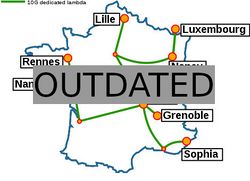Grid5000:Home
|
Grid'5000 is a large-scale and versatile testbed for experiment-driven research in all areas of computer science, with a focus on parallel and distributed computing including Cloud, HPC and Big Data. Key features:
Older documents:
|
Random pick of publications
Five random publications that benefited from Grid'5000 (at least 2929 overall):
- Enzo Isnard, Sébastien Héron, Stéphane Lanteri, Mahmoud Elsawy. Hybrid model to simulate optical systems combining metasurfaces and classical refractive elements. 2025. hal-05290353 view on HAL pdf
- Barbara Gendron, Gaël Guibon. SEC: Context-Aware Metric Learning for Efficient Emotion Recognition in Conversation. Proceedings of the 14th Workshop on Computational Approaches to Subjectivity, Sentiment, & Social Media Analysis (WASSA at ACL 2024), Aug 2024, Bangkok, Thailand. hal-04702997 view on HAL pdf
- Jérôme Rouzé, Nouredine Melab, Daniel Tuyttens. A Parallel Genetic Algorithm for Qubit Mapping on Noisy Intermediate-Scale Quantum Machines. International Conference in Optimization and Learning - OLA 2024, May 2024, Dubrovnik, Croatia. hal-04916922 view on HAL pdf
- Wedan Emmanuel Gnibga, Anne Blavette, Anne-Cécile Orgerie. Energy-related Impact of Redefining Self-consumption for Distributed Edge Datacenters. IGSC 2024 - 15th International Green and Sustainable Computing Conference, Nov 2024, Austin, United States. pp.1-7, 10.1109/IGSC64514.2024.00011. hal-04770489 view on HAL pdf
- Mouhamed Amine Bouchiha. Advancing Blockchain-based Reputation Systems : Enhancing Effectiveness, Privacy Preservation, and Scalability. Computer Science cs. Université de La Rochelle, 2024. English. NNT : 2024LAROS006. tel-04874759 view on HAL pdf
Latest news
Failed to load RSS feed from https://www.grid5000.fr/mediawiki/index.php?title=News&action=feed&feed=atom: Error parsing XML for RSS
Grid'5000 sites
Current funding
As from June 2008, Inria is the main contributor to Grid'5000 funding.
INRIA |
CNRS |
UniversitiesUniversité Grenoble Alpes, Grenoble INP |
Regional councilsAquitaine |


